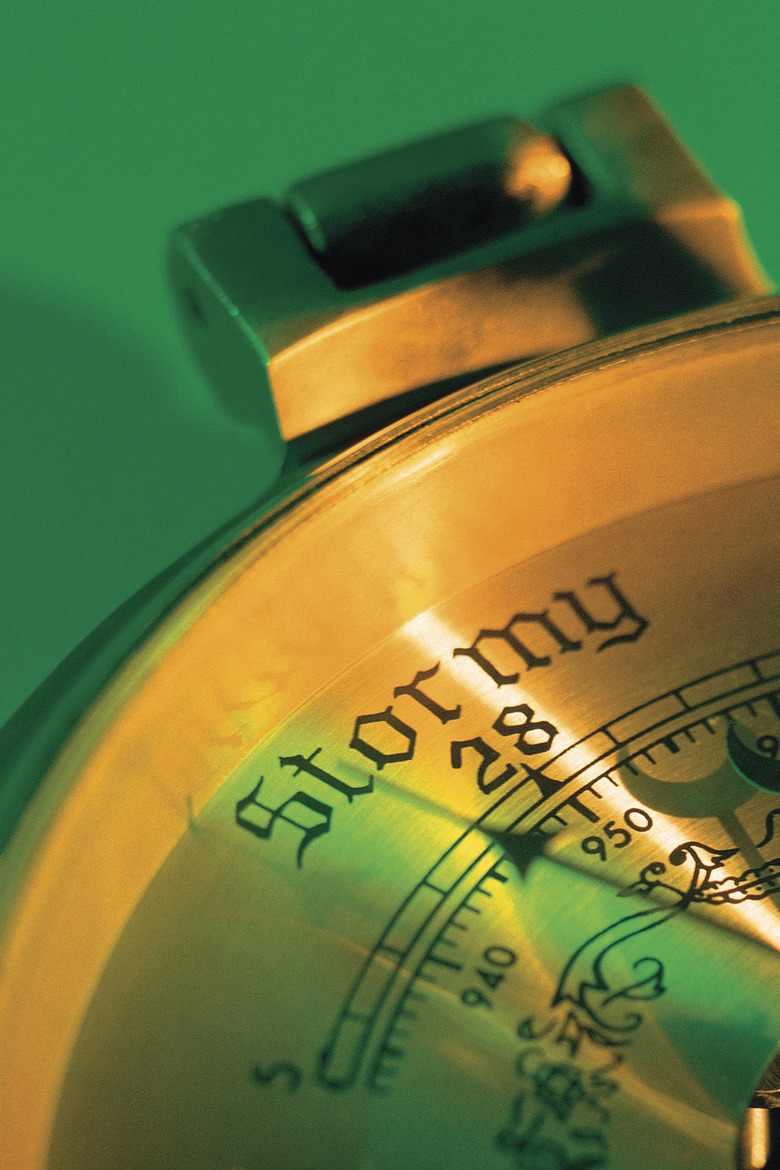How To Make A Barometer With Mineral Oil
Barometers measure changes in the air pressure. Because changes in the weather are related to changes in air pressure, barometers can be used to predict changes in the weather. If liquid level in the barometer drops, the air pressure has dropped and rain is likely on the way. If liquid level in the barometer stays high, the air pressure is also high and more clear weather will probably follow. A barometer can be constructed using inexpensive items, allowing you to follow simple weather patterns.
Simple Two-Part Barometer
Simple Two-Part Barometer
A liquid barometer that reacts to large changes in atmospheric pressure can be made from two small containers stacked on top of one another. The lower container is the liquid reservoir and needs a wide neck that can accommodate the upper container. The upper container is inverted and its opening submerged in the lower container without touching the bottom. One suggestion is a ketchup bottle in a tall drinking glass. The thin, but wide, ketchup bottle could rest on the top edge of the glass. As the air pressure increases, the liquid is pushed down in the lower container, forcing it into the upper container. By making calibration marks on the upper container, relative air pressure changes can be measured.
Thin-Tube Barometer
Thin-Tube Barometer
A barometer that is more sensitive to daily changes in air pressure adds a thin tube between the two containers. Connect the thin tube, the longer the better and made from transparent glass or plastic, to a sealed upper container so that no air can enter except through the tube. Heat the upper container, then submerge the bottom of the tube in the lower container. As the upper container cools, the volume of the air will decrease and draw liquid up into middle of the tube. The changes in atmospheric pressure are measured by observing the rising and falling liquid level in the tube. The small diameter of the tube allows this barometer to respond to smaller changes in pressure.
Adjustments to Improve Performance
Adjustments to Improve Performance
The diameter of the tube, or container, where the liquid rises and falls is important to the performance of the barometer. To make the barometer more sensitive, decrease the diameter of the tube connecting the liquid reservoir and the upper sealed container or increase the volume of the upper container. Temperature changes also affect performance. Insulate the upper sealed container so that temperature fluctuations do not easily affect the air pressure inside which would make the barometer act like a thermometer.
Mineral Oil
Mineral Oil
Mineral oil is the liquid of choice when constructing a homemade barometer and is commonly sold in drug stores. Water can be used, but water evaporates quickly and is heavier than mineral oil. Mineral oil has a low vapor pressure, so it will not readily evaporate, and it is not as dense as water, so the liquid level in the barometer will rise with a much smaller increase in air pressure compared to water. Therefore, a barometer made with mineral oil is more consistent and more accurate than if the barometer was made with water.
References
- Teach Engineering: Hands-on Activity: Building a Barometer
- Salem Clock Shop: Weather Glass Barometer
- Techlib.com: Barometers
- The Everyday Science Sourcebook; Lawrence F. Lowery
Cite This Article
MLA
Bush, Joshua. "How To Make A Barometer With Mineral Oil" sciencing.com, https://www.sciencing.com/make-barometer-mineral-oil-18164/. 24 April 2017.
APA
Bush, Joshua. (2017, April 24). How To Make A Barometer With Mineral Oil. sciencing.com. Retrieved from https://www.sciencing.com/make-barometer-mineral-oil-18164/
Chicago
Bush, Joshua. How To Make A Barometer With Mineral Oil last modified March 24, 2022. https://www.sciencing.com/make-barometer-mineral-oil-18164/
